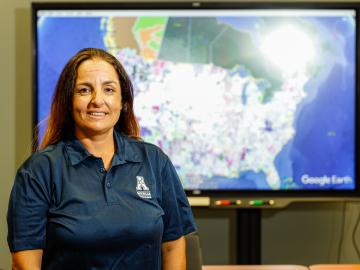
Filter News
Area of Research
- (-) Computational Biology (2)
- (-) Energy Science (106)
- Biological Systems (1)
- Biology and Environment (36)
- Computational Engineering (3)
- Computer Science (10)
- Electricity and Smart Grid (3)
- Energy Sciences (1)
- Fuel Cycle Science and Technology (1)
- Functional Materials for Energy (2)
- Fusion and Fission (6)
- Isotopes (8)
- Materials (54)
- Materials for Computing (9)
- Mathematics (1)
- National Security (43)
- Neutron Science (30)
- Nuclear Science and Technology (2)
- Quantum information Science (9)
- Sensors and Controls (1)
- Supercomputing (73)
News Topics
- (-) Big Data (5)
- (-) Biomedical (8)
- (-) Energy Storage (71)
- (-) Grid (39)
- (-) Mathematics (2)
- (-) National Security (5)
- (-) Quantum Science (2)
- 3-D Printing/Advanced Manufacturing (79)
- Advanced Reactors (6)
- Artificial Intelligence (9)
- Bioenergy (26)
- Biology (13)
- Biotechnology (4)
- Buildings (38)
- Chemical Sciences (14)
- Clean Water (8)
- Composites (17)
- Computer Science (26)
- Coronavirus (13)
- Critical Materials (9)
- Cybersecurity (8)
- Environment (54)
- Exascale Computing (2)
- Fossil Energy (2)
- Frontier (2)
- Fusion (1)
- High-Performance Computing (8)
- Hydropower (3)
- Isotopes (1)
- Machine Learning (7)
- Materials (35)
- Materials Science (26)
- Mercury (3)
- Microelectronics (1)
- Microscopy (8)
- Molten Salt (1)
- Nanotechnology (8)
- Neutron Science (12)
- Nuclear Energy (7)
- Partnerships (12)
- Physics (1)
- Polymers (11)
- Security (6)
- Simulation (4)
- Space Exploration (3)
- Statistics (1)
- Summit (5)
- Transportation (66)
Media Contacts

Scientists at the Department of Energy’s Oak Ridge National Laboratory have developed a new method to peer deep into the nanostructure of biomaterials without damaging the sample. This novel technique can confirm structural features in starch, a carbohydrate important in biofuel production.

Researchers at ORNL demonstrated that sodium-ion batteries can serve as a low-cost, high performance substitute for rechargeable lithium-ion batteries commonly used in robotics, power tools, and grid-scale energy storage.

Energy storage startup SPARKZ Inc. has exclusively licensed five battery technologies from the Department of Energy’s Oak Ridge National Laboratory designed to eliminate cobalt metal in lithium-ion batteries. The advancement is aimed at accelerating the production of electric vehicles and energy storage solutions for the power grid.

The formation of lithium dendrites is still a mystery, but materials engineers study the conditions that enable dendrites and how to stop them.

Oak Ridge National Laboratory researchers created a geothermal energy storage system that could reduce peak electricity demand up to 37% in homes while helping balance grid operations.

To better determine the potential energy cost savings among connected homes, researchers at Oak Ridge National Laboratory developed a computer simulation to more accurately compare energy use on similar weather days.

Isabelle Snyder calls faults as she sees them, whether it’s modeling operations for the nation’s power grid or officiating at the US Open Tennis Championships.

A team of researchers at Oak Ridge National Laboratory have demonstrated that designed synthetic polymers can serve as a high-performance binding material for next-generation lithium-ion batteries.

Ionic conduction involves the movement of ions from one location to another inside a material. The ions travel through point defects, which are irregularities in the otherwise consistent arrangement of atoms known as the crystal lattice. This sometimes sluggish process can limit the performance and efficiency of fuel cells, batteries, and other energy storage technologies.

Scientists at Oak Ridge National Laboratory have developed a low-cost, printed, flexible sensor that can wrap around power cables to precisely monitor electrical loads from household appliances to support grid operations.


